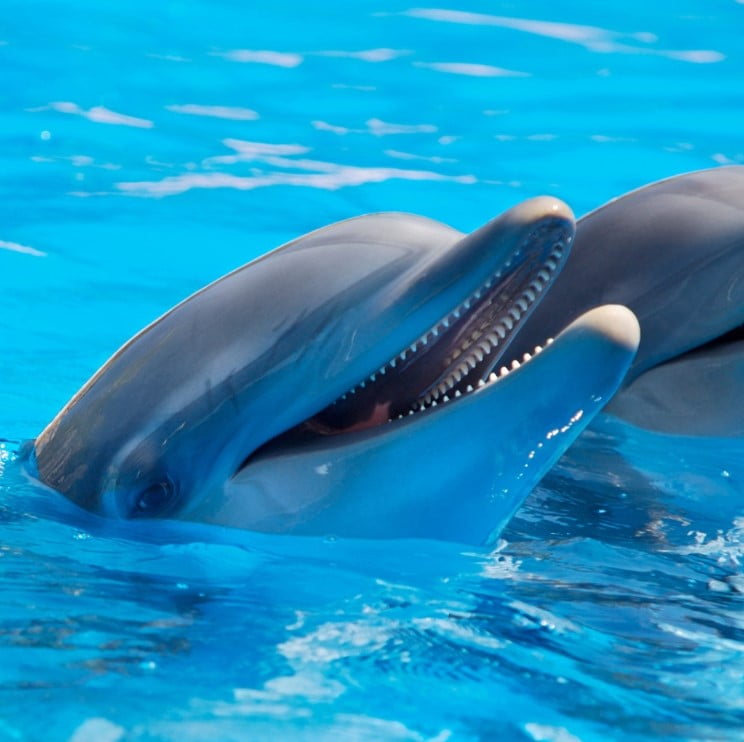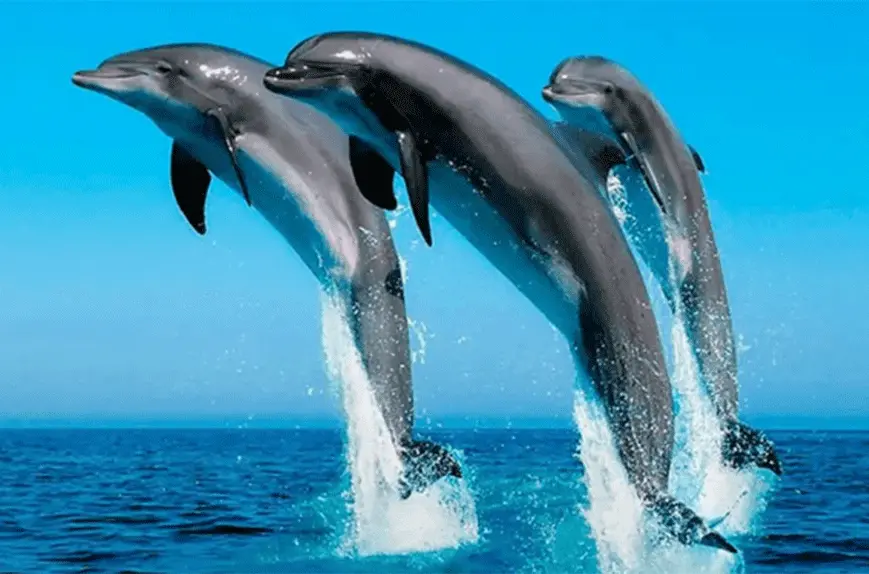Dolphins, those captivating creatures of the sea, have long captured the imagination of humans with their intelligence, agility, and playful nature. As we delve into the enchanting world of dolphins, we discover a multitude of intriguing and captivating dolphins interesting facts that make these marine mammals truly remarkable. From their global presence in various environments to their extraordinary abilities such as echolocation and half-brain sleeping, dolphins have fascinated scientists and enthusiasts alike.
Dolphins Interesting Facts

Image Source: Instagram @seasavefoundation
Here are some top dolphins interesting facts:
- Dolphins, being widespread marine mammals, can be observed inhabiting oceans worldwide. Moreover, they demonstrate an impressive ability to adapt to a multitude of environments, encompassing coastal regions, expansive open seas, and, intriguingly, even certain freshwater rivers and lakes.
- While most dolphins are known for their presence in salt water, some species have adapted to live in freshwater environments. Freshwater dolphins, such as the Amazon River dolphin and the Ganges River dolphin, navigate through river systems in South America and Asia. These dolphins have evolved unique physical and behavioural characteristics to survive in the challenging conditions of freshwater ecosystems.
- Sound is the cornerstone of communication, navigation, and food acquisition for dolphins. Underwater noise pollution, caused by human activities such as shipping, sonar systems, and oil exploration, can disrupt their natural behaviours. High levels of noise can interfere with their ability to communicate, locate prey, and navigate, posing a significant threat to their survival.
- Dolphins are incredibly fast swimmers and can reach impressive speeds. Some species, like the common dolphin, can swim at speeds of up to 60 km/h (37 mph). Their streamlined bodies and powerful tails enable them to move swiftly through the water.
- Dolphins have a unique way of catching and consuming fish. They use a technique called “porpoising” where they leap out of the water to catch their prey. Dolphins also have sharp teeth to grasp and hold onto their slippery meals before swallowing them whole.
- Dolphins exhibit long-term attachment to their mothers.
- Dolphins possess two stomachs.
- They are capable of diving up to depths of 1,000 feet.
- The lifespan of dolphins can reach up to 50 years.
- Their skin is delicate but possesses a remarkable ability to heal quickly.
Fun Facts About Dolphins
- Dolphins exhibit playful behaviour, and one of their favourite pastimes is blowing bubbles. They create bubble rings by exhaling air through their blowholes underwater, manipulating the bubbles with their snouts. It is believed that dolphins engage in this behaviour for amusement or as a form of communication.
- Dolphins are highly vocal creatures and communicate using a variety of clicks, whistles, and body movements. They produce a wide range of sounds, each with its own meaning and purpose. Communication is crucial for maintaining social bonds, coordinating group activities, and finding food.
- Dolphins are renowned for their high level of intelligence. They possess large brains relative to their body size, second only to whales in the animal kingdom. Their cognitive abilities include problem-solving, self-awareness, and the ability to learn complex tasks.
- Dolphins have the remarkable ability to sleep with one eye open and half of their brain awake. This phenomenon, known as unihemispheric sleep, allows them to maintain basic functions like breathing and remaining vigilant for potential threats while resting.
- Dolphins often become entangled in fishing gear, such as nets and lines, causing injuries and even death. They may accidentally get caught while chasing fish that are being targeted by commercial fishing operations. Bycatch, the unintentional capture of dolphins and other marine species, is a significant conservation concern that threatens their populations.
- There are approximately 40 different species of dolphins.
- Dolphins display compassionate behaviour by assisting sick or injured members of their pod.
- Dolphins have the ability to recognize and respond to individual names.
- They are known for their amiable nature towards both humans and other animals.
- Killer whales, the largest type of dolphin, are part of the dolphin family.
Amazing Facts About Dolphins

Image Source: Instagram @palcura
- Certain dolphins can swim at speeds of up to 20 miles per hour.
- Dolphins are capable of migrating in search of food when resources are scarce.
- Dolphins are remarkable marine mammals that require air and give birth to live young, necessitating regular surfacing for breathing.
- The gestation period for dolphins spans from nine to 16 months. During this time, the mother nourishes her offspring with milk.
- Resident orcas’ sons and daughters remain with their maternal family for their entire lives.
- Dolphins primarily consume fish, squid, and crustaceans. Rather than chewing, they may break their food into smaller pieces before swallowing.
- All dolphins possess conical-shaped teeth, with varying numbers. For instance, a Risso’s dolphin has 14 teeth, while a spinner dolphin can have 240.
- The largest dolphin species is the orca, also known as the killer whale. Conversely, the Hector’s dolphin and the Franciscana represent two of the smallest dolphin species.
- Four river dolphin species inhabit the major waterways of Asia and South America.
- Dolphins communicate through an extensive range of vocalizations, including clicks, whistles, and squeals. These sounds are crucial for their well-developed communication and echolocation skills.
- Lifespan varies across dolphin species, ranging from approximately 20 years in smaller dolphins to 80 years or more in larger species like orcas.
- The most critically endangered dolphin is the Maui’s dolphin, a sub-species of the New Zealand dolphin, with fewer than 50 individuals remaining. Additionally, the vaquita, a type of porpoise, has less than 10 surviving individuals.
- The term “dolphin” originates from the Greek words “delphis” and “delphus,” which signify “fish with a womb.”
- Dolphins typically inhabit shallow waters, yet they have the remarkable capability to plunge to depths of up to 900 feet (274 meters).
- Contrarily, dolphins don’t drink water as they acquire their hydration through the consumption of their food.
READ ALSO: Fun Facts About Seahorses | Acrobats Of The Ocean
Other Interesting Findings
These are some general dolphins interesting facts you should know:
- Dolphins have a skeletal structure characterized by lightness, high flexibility, and relatively weaker bones compared to land animals.
- Dolphins possess highly effective healing processes that prevent easy haemorrhaging and contribute to their survival.
- Dolphins are believed to have the longest memory of all animals.
- Dolphins utilize echolocation/sonar to navigate through water, overcome obstacles, and hunt for prey.
- Dolphins possess an exceptionally sophisticated and advanced hearing system that enables even blind individuals to survive.
- Dolphins lack a sense of smell and have a relatively limited sense of taste.
- Dolphins can employ their noses to fend off sharks.
- Dolphins have smooth skin, which aids in reducing drag while swimming. Their outer skin layer can regenerate in a mere two hours.
- Dolphins allocate approximately eight hours per day for sleep and spend the remaining time engaged in swimming activities.
- Typically, dolphins resurface to breathe around three to five times per minute, although they possess the remarkable ability to hold their breath for up to 15 minutes.
- Dolphins exhibit a unique sleeping pattern where they rest with only one brain hemisphere at a time, entering a state of slow-wave sleep. This allows them to maintain enough consciousness to breathe and remain vigilant against potential predators.
- During the gestation period, female dolphins carry a single baby, although, on rare occasions, they may give birth to twins.
- Following birth, female dolphins care for their calves for a duration of 11 to 18 months.
- Dolphin mothers provide their offspring with exceptionally nutritious and fatty milk.
- On average, dolphins have a life expectancy of 25 years, although some individuals can live up to 50 years.
- Demonstrating their empathetic nature, dolphins frequently remain alongside sick or injured individuals for extended periods, exhibiting altruistic behaviour.










